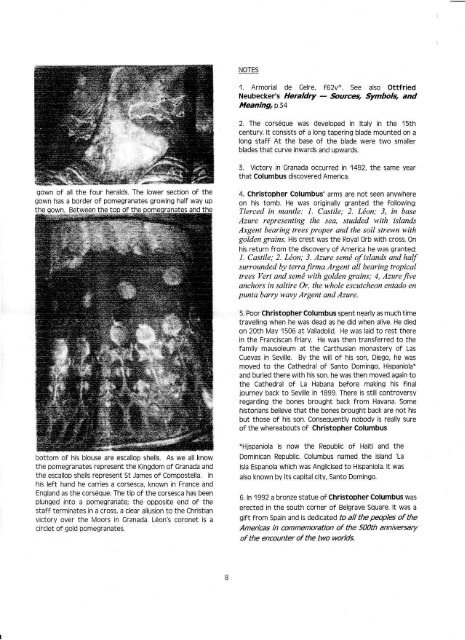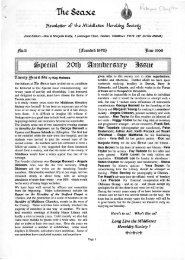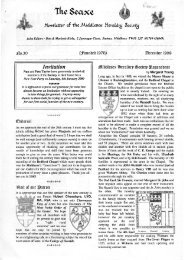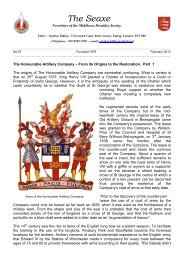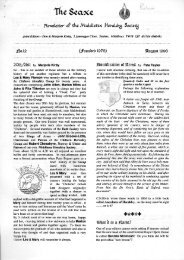The Seaxe - Middlesex Heraldry Society
The Seaxe - Middlesex Heraldry Society
The Seaxe - Middlesex Heraldry Society
Create successful ePaper yourself
Turn your PDF publications into a flip-book with our unique Google optimized e-Paper software.
gown of all the four heralds. <strong>The</strong> lower section of the<br />
gown has a border of pomegranates growing half way up<br />
the gown. Between the top of the pomegranates and the<br />
bottom of his blouse are escallop shells. As we all know<br />
the pomegranates represent the Kingdom of Granada and<br />
the escallop shells represent St James of Compostella. In<br />
his left hand he carries a corsesca, known in France and<br />
England as the corseque. <strong>The</strong> tip of the corsesca has been<br />
plunged into a pomegranate; the opposite end of the<br />
staff terminates in a cross, a clear allusion to the Christian<br />
victory over the Moors in Granada. Leon's coronet is a<br />
circlet of gold pomegranates.<br />
8<br />
NOTES<br />
1. Armorial de Gelre, f62v°. See also Ottfried<br />
Neubecker's <strong>Heraldry</strong> — Sources, Symbols, and<br />
Meaning, p.34<br />
2. <strong>The</strong> corseque was developed in Italy in the 15th<br />
century. It consists of a long tapering blade mounted on a<br />
long staff At the base of the blade were two smaller<br />
blades that curve inwards and upwards.<br />
3. Victory in Granada occurred in 1492, the same year<br />
that Columbus discovered America.<br />
4. Christopher Columbus' arms are not seen anywhere<br />
on his tomb. He was originally granted the following:<br />
Tierced in mantle: 1. Castile; 2. Leon; 3, in base<br />
Azure representing the sea, studded with islands<br />
Argent bearing trees proper and the soil strewn with<br />
golden grains. His crest was the Royal Orb with cross. On<br />
his return from the discovery of America he was granted:<br />
1. Castile; 2. Leon; 3. Azure seme of islands and half<br />
surrounded by terra firma Argent all bearing tropical<br />
trees Vert and seme with golden grains; 4, Azure five<br />
anchors in saltire Or, the whole escutcheon entado en<br />
punta barry wavy Argent and Azure.<br />
5. Poor Christopher Columbus spent nearly as much time<br />
travelling when he was dead as he did when alive. He died<br />
on 20th May 1506 at Valladolid. He was laid to rest there<br />
in the Franciscan friary. He was then transferred to the<br />
family mausoleum at the Carthusian monastery of Las<br />
Cuevas in Seville. By the will of his son, Diego, he was<br />
moved to the Cathedral of Santo Domingo, Hispaniola*<br />
and buried there with his son. he was then moved again to<br />
the Cathedral of La Habana before making his final<br />
journey back to Seville in 1899. <strong>The</strong>re is still controversy<br />
regarding the bones brought back from Havana. Some<br />
historians believe that the bones brought back are not his<br />
but those of his son. Consequently nobody is really sure<br />
of the whereabouts of Christopher Columbus<br />
*Hispaniola is now the Republic of Haiti and the<br />
Dominican Republic. Columbus named the island la<br />
Isla Espanola which was Anglicised to Hispaniola. It was<br />
also known by its capital city, Santo Domingo.<br />
6. In 1992 a bronze statue of Christopher Columbus was<br />
erected in the south corner of Belgrave Square. It was a<br />
gift from Spain and is dedicated to all the peoples of the<br />
Americas in commemoration of the 500th anniversary<br />
of the encounter of the two worlds.


